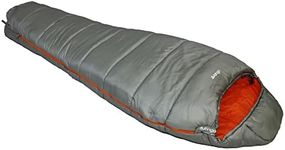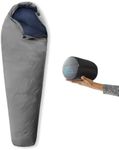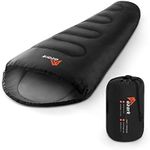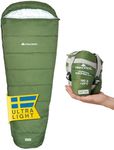Buying Guide for the Best Compact Sleeping Bag
Choosing the right compact sleeping bag is crucial for ensuring a comfortable and restful sleep during your outdoor adventures. A compact sleeping bag is designed to be lightweight and easy to carry, making it ideal for backpacking, hiking, and camping trips where space and weight are at a premium. When selecting a sleeping bag, consider the climate and conditions you'll be facing, as well as your personal comfort preferences. Understanding the key specifications will help you make an informed decision that best suits your needs.Temperature RatingThe temperature rating of a sleeping bag indicates the lowest temperature at which the bag will keep the average sleeper warm. This is important because it helps you choose a bag that will keep you comfortable in the conditions you expect to encounter. Temperature ratings are usually divided into three categories: summer (above 35°F or 2°C), 3-season (10°F to 35°F or -12°C to 2°C), and winter (below 10°F or -12°C). Choose a temperature rating based on the coldest conditions you expect to face. If you tend to sleep cold, consider selecting a bag with a lower temperature rating for added warmth.
WeightWeight is a critical factor for compact sleeping bags, especially if you plan to carry it over long distances. A lighter sleeping bag is easier to pack and transport, making it ideal for backpacking. Sleeping bags can range from ultra-light (under 2 pounds or 0.9 kg) to heavier options (over 4 pounds or 1.8 kg). Consider how much weight you are willing to carry and balance it with the warmth and comfort you need. If you're hiking long distances, prioritize a lighter bag, but ensure it still meets your temperature requirements.
Insulation TypeThe insulation type in a sleeping bag affects its warmth, weight, and how well it compresses. There are two main types: down and synthetic. Down insulation is lightweight, compressible, and offers excellent warmth, but it can be more expensive and loses insulating power when wet. Synthetic insulation is bulkier and heavier but retains warmth when wet and is generally more affordable. Choose down if you need a lightweight, compressible bag and can keep it dry. Opt for synthetic if you expect wet conditions or are looking for a more budget-friendly option.
ShapeThe shape of a sleeping bag affects its warmth and comfort. Common shapes include mummy, rectangular, and semi-rectangular. Mummy bags are snug and efficient at retaining heat, making them ideal for cold conditions. Rectangular bags offer more room to move and are better for warmer climates or those who value comfort over warmth. Semi-rectangular bags offer a compromise between warmth and space. Choose a shape based on your sleeping style and the conditions you'll face. If you prioritize warmth and weight, a mummy bag is best. For more comfort and space, consider a rectangular or semi-rectangular bag.
Packed SizePacked size refers to how small a sleeping bag can be compressed for transport. This is important for saving space in your backpack or luggage. Smaller packed sizes are ideal for backpacking and hiking, where space is limited. Sleeping bags with down insulation typically compress smaller than synthetic ones. Consider the space you have available and how important a compact size is for your trip. If space is a premium, prioritize a sleeping bag with a smaller packed size, but ensure it still meets your warmth and comfort needs.















